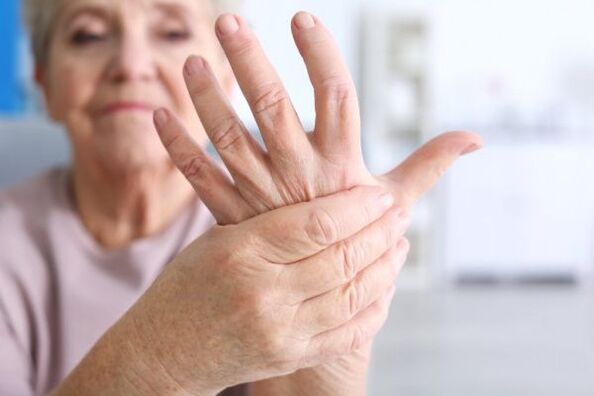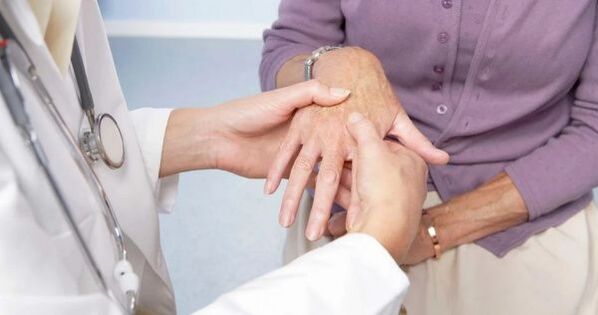
Pain in the fingersoccurs when bones, joints, soft tissues, blood vessels, nerves are affected. It can be dull, sharp, weak, intense, permanent, periodic, short-lived. It is often associated with physical activity, weather conditions and other factors. Accompanying external disturbances are possible: deformations, changes in color and temperature, swelling. To determine the cause of pain in the fingers, the results of a survey, external examination, X-ray examination and other methods are used. Until the diagnosis is made, rest is recommended, sometimes taking painkillers.
Why do my fingers hurt?
Traumatic injuries
Finger injury is characterized by moderate pain. Then the intensity of the pain gradually decreases. Swelling, redness, cyanosis, bleeding are possible. The function of the finger is slightly impaired. Hematomas on the palmar surface of the fingers are manifested by moderate pain, peeling of the skin with the formation of a cavity filled with dark blood. In subungual hematomas the pain is intense, trembling, throbbing, intensified by lowering the brush. Partial or complete detachment of the nail plate is possible.
The broken finger is accompanied by severe explosive pain at the time of injury. Subsequently, the pain decreases slightly, but remains intense. The finger is blue, swollen, its functions are severely impaired. Deformation, crepitation, pathological mobility can be detected. Acute pain is observed when the finger is dislocated. The finger is deformed, swollen, when trying to move in the affected joint is determined by spring resistance.
When freezing in the first hours, the pain is mild, tingling. Then the pain syndrome intensifies, acquires a burning character. The finger swells, becomes cyanotic. With deep frostbite there is no sensitivity in the distal parts, the fingers are cold, pale, the pain worries on the border between healthy and affected tissues.
Infectious lesions
Panaritium is characterized by rapidly increasing pain, swelling, redness, cyanosis, abscess formation. Pains trembling, throbbing, depriving the night of sleep. Particularly painful sensations are expressed with the foot panaritium and deep forms of the disease (bone, joint, tendon). In superficial forms of panaritium (skin, periungual, subcutaneous, subungual) the general condition suffers slightly, with deep symptoms of intoxication, fever.
Chinga develops in people involved in cutting and processing carcasses of marine game, occurs with minor injuries: abrasions, wounds, cracks. It manifests as dull, slight pain in the wound area, which after 1-2 days is replaced by pain in the finger joint (usually proximal). The pain increases, becomes painful, throbbing, supplemented by swelling, pallor, cyanosis of the finger.
Arthritis
Pain in the joints of the fingers in rheumatoid arthritis is symmetrical. 1 degree of activity is manifested by mild arthralgia, rapidly disappearing stiffness. In grade 2 the pain is disturbed at rest and during movement, combined with prolonged stiffness, restriction of movement, redness. Grade 3 is characterized by intense constant pain, constant stiffness, swelling, redness. The movement is very limited.
Gouty arthritis of the fingers is more common in women. One or more joints may be affected. The pain is usually sharp, sharp, combined with edema, hyperemia, impaired function and fever. Deleted symptoms are less common - mild pain and slight redness in a satisfactory general condition.
Psoriatic arthritis occurs suddenly or gradually. In the first case the pain is moderate, increasing, in the second - sharp, intense. At the height of the disease, the typical picture includes pain that intensifies at night and at rest, weight loss during the day, with movements, swelling of the fingers, purple-bluish discoloration of the skin. The distal interphalangeal joints are most commonly affected. Over time, many deformations occur.
In post-traumatic arthritis, one joint is affected. Infectious-allergic forms of the disease, developing against the background of bacterial and viral infections, are characterized by numerous lesions. In occupational peripheral arthritis, the busiest joints of the fingers are involved. The pain in all these forms of pathology intensifies at night, weakens during the day and is complemented by morning stiffness, local swelling and difficulty moving. Deformations are noted during long strokes.

Degenerative pathologies
In osteoarthritis of the hands, the pain is initially indeterminate, periodic, short-lived. There is morning stiffness. Subsequently, the painful sensations intensify, become prolonged, sometimes burning, are noted with all movements, limit daily activity and perform delicate operations. The nodes of Heberden and Bouchard are formed. Lateral deformations are formed.
Diseases of the ligaments and tendons
Patients suffering from stenotic ligamentitis are concerned about pain along the palmar surface at the base of the affected finger. Initially, the pain syndrome appears only with pressure and small movements, then remains at rest. Movements are limited, accompanied by clicking. Over time, flexion contracture develops, after clicking, the pain is transferred to the arm.
In the initial stage, de Quervain's disease is manifested by pain during abduction, hyperextension of the first finger. Subsequently, painful, pressing pains appear with each physical activity, some patients are disturbed even at rest. Typical irradiation in the distal phalanx or to the forearm on the side of the first finger.
Angiotrophoneurosis
Raynaud's syndrome is caused by vasospasm accompanied by paroxysmal tingling, cold fingers. The pain appears in the second phase of the attack, has a fracturing nature, combined with a burning sensation, fullness. The pain syndrome is short-lived, replaced by a feeling of warmth, redness of the distal parts of the hands. The pathology occurs in various diseases of different origins, including:
- rheumatoid arthritis;
- systemic lupus erythematosus;
- scleroderma;
- Sharpe's syndrome;
- antisynthetic syndrome;
- thromboangiitis obliterating the upper extremities;
- endocrine, metabolic, occupational pathologies.
In the absence of other diseases that provoke this condition, they speak of Raynaud's disease with a similar pain syndrome. This form is more common in women.
Erythromelalgia occurs alone or is formed in patients with endocrine, neurological, hematological diseases. Manifested by paroxysmal attacks of burning, burning pain, swelling, redness of the fingers. It is possible for pain to spread from one limb to another or to occur in both limbs at the same time. The attacks of pain are so strong that they interfere with any movement. The pain decreases when cooling and raising the arm, increases when warming and lowering the arms.
Neurological pathologies
Pain in the fingers occurs when the nerves are damaged, spreads in the area of innervation, has a shooting or burning character, is complemented by sensory disorders, autonomic and trophic disorders. Possible neurological causes:
- Neuropathy of the median nerve.The pain is localized on the palmar side of the I-III fingers, combined with the inability to bend the fingers, clench the fist, oppose the I finger.
- carpal tunnel syndrome.A type of median nerve neuropathy caused by compression of nerve fibers at the level of the wrist. Localization of pain - as in the previous case. Typical nocturnal seizures, reduction of pain when lowering the arms, shaking the brushes.
- Radial nerve neuropathy.In lesions at the level of the forearm and wrist, pain is observed on the posterior surface of the first finger and hand, sometimes spreading to the second and third fingers. Irradiation in the forearm, tingling in the back of the hand are typical.
- Ulnar nerve neuropathy.The pain is localized mainly in the elbow joint, but can radiate to the hand, IV-V fingers. The pain syndrome often worsens in the morning.
Tumors
Benign tumors that affect the bones of the fingers include chondromas and osteoid osteomas. Chondromas are manifested by non-intense pain sensations with unclear localization, osteoid osteomas - with sharp pain in the affected area. Malignant neoplasia of the fingers is rare.
Other reasons
Pain in the fingers and hands is observed in patients with spasm of writing, which develops in occupational neurosis, some other mental and neurological disorders. Pain occurs when writing, working on a computer or typewriter. They break, pull, complemented by tremors, sudden weakness of the arm, local convulsions. In addition, soreness in the fingers can be detected in the following pathologies:
- leukemia: Macroglobulinemia on Waldenström.
- Tumors of the adrenal glands: aldosteroma.
- Complications of diabetes: diabetic neuropathy.
- Vascular diseases: distal digital embolism due to occlusion of the subclavian artery.
- hereditary diseases: Fabry's disease.
- Children's diseases: neuro-arthritic diathesis.
Diagnosis
Orthopedic traumatologists are working to determine the causes of finger pain. The diagnosis is made on the basis of a conversation with the patient, data from an external examination, additional tests. The diagnostic program includes:
- Research. The doctor determines when and under what circumstances the pain syndrome and other symptoms first appeared, determines the characteristics of the dynamics of the disease, the factors provoking improvement or deterioration of the patient's condition. Studying life history, family history.
- Physical examination. The specialist assesses the appearance of the fingers, reveals deformities, inflammation, cracks, dry skin, temperature and color disorders, swelling and other manifestations of pathology. Investigates sensitivity, range of motion, pulsation in peripheral arteries.
- Radiography.It is performed in two projections by capturing the affected fingers or the whole hand. Confirms the presence of fractures, sprains, tumors, inflammatory and degenerative processes, areas of destruction of solid structures in deep panaritium.
- Electrophysiological studies.They are performed for pain of neurological origin in order to clarify the degree of nerve damage, to assess the condition of the muscles and nerve conduction.
- Laboratory tests. It is produced to determine inflammation, assess the general condition of the body, detect specific markers in collagenosis.
According to the indications, patients are referred for consultation with an endocrinologist, neurologist, vascular surgeon and other specialists. Assign CT, MRI, other instrumental techniques. Perform a biopsy of hard and soft structures for cytological or histological examination.

Treatment
First aid
For traumatic injuries, a cold, raised limb position is recommended. The arm is fixed with a splint or improvised materials (eg boards). The brush is lifted up or a scarf is used. In case of intense pain syndrome an analgesic is given, in the absence of external damage chloroethyl is used.
The help with diseases is determined by the nature of the pathology - a change in the position of the limb, warming or, conversely, cooling can help. The most common measure is rest, but in some diseases (carpal tunnel syndrome, arthritis) the pain syndrome decreases while maintaining motor activity. Acute shivering pain, pronounced signs of inflammation, general hyperthermia are the reason for urgent consultation with a specialist.
Conservative therapy
In case of sprains and fractures, local anesthesia is performed, reduction is performed and a plaster bandage is applied. Conservative treatment of traumatic and non-traumatic pathologies of the fingers includes the following activities:
- Protection mode. It is chosen taking into account the nature and severity of the disease. Possible recommendations for limiting the load, use of orthopedic devices, imposition of a plaster bandage.
- Medical therapy. Non-steroidal anti-inflammatory drugs, antibiotics, drugs to improve blood circulation, neurotropic drugs are used. According to the indications, blockades with corticosteroids are performed.
- Non-drug methods. Exercise therapy, massage, physiotherapy, manual therapy, kinesiotaping are prescribed.
Surgical interventions
Surgeries are performed when conservative methods are ineffective, to reduce time and improve long-term treatment outcomes. Taking into account the characteristics of the lesion, the following is done:
- Injuries: fixation of fractures and sprains with knitting needles, necrectomy and amputation of fingers in frostbite.
- Infectious diseases: opening, drainage of panaritium, in severe lesions in some cases - amputation or deartculation.
- Diseases of the tendons and ligaments: dissection of the dorsal ligament and excision of adhesions in de Quervain disease, dissection of the annular ligaments in stenotic ligamentitis.
- Neoplasms: removal of neoplasia, bone resection.
- Neurological diseases: decompression of nerves.
Antibiotic therapy is prescribed after the operation. Patients undergo comprehensive rehabilitation aimed at maximum recovery of hand function.



















